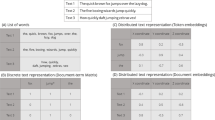Abstract
In order to build software that can deeply understand people and our problems, we require computational tools that give machines the capacity to learn and reason about everyday life. We describe three commonsense knowledge bases that take unconventional approaches to representing, acquiring, and reasoning with large quantities of commonsense knowledge. Each adopts a different approach — ConceptNet is a large-scale semantic network, LifeNet is a probabilistic graphical model, and StoryNet is a database of story-scripts. We describe the evolution, architecture and operation of these three systems, and conclude with a discussion of how we might combine them into an integrated commonsense reasoning system.
Similar content being viewed by others
References
Davis E: 'Representations of commonsense knowledge', San Mateo, CA, Morgan Kaufmann (1990).
Lenat D: 'CYC: A large-scale investment in knowledge infrastructure', Communications of the ACM, 38, No 11, pp 33—38 (1995).
Mueller E T: 'Common sense in humans', (2001) — http://www.signiform.com/erik/pubs/cshumans.htm
Moldovan D I et al: 'Performance issues and error analysis in an open-domain question answering system', ACM Trans Inf Syst, 21, No 2, pp 133—154 (2003).
Davis E and Morgenstern L: 'Introduction: progress in formal commonsense reasoning', AI Journal: Special Issue on Logical Formalizations and Commonsense Reasoning, 153, No 1—2, pp 1—12 (2004).
Anthes G: 'Firm aims to 'computerise' commonsense', (2002) — http://www.cnn.com/2002/TECH/industry/04/11/ memome.project.idg/index.html. Accessed March 28, 2004.
Singh P, Lin T, Mueller E T, Lim G, Perkins T and Zhu W L: 'Open mind commonsense: knowledge acquisition from the general public', Proceedings of the First International Conference on Ontologies, Databases, and Applications of Semantics for Large Scale Information Systems, Lecture Notes in Computer Science, No 2519, Heidelberg, Springer-Verlag (2002).
Singh P: 'The public acquisition of commonsense knowledge', in Proceedings of AAAI Spring Symposium: 'Acquiring (and Using) Linguistic (and World) Knowledge for Information Access', Palo Alto, CA, AAAI (2002).
Fellbaum C (Ed): 'WordNet: An Electronic Lexical Database', Cambridge, MA, MIT Press (1998).
Chklovski T and Mihalcea R: 'Building a sense tagged corpus with Open Mind word expert', in Proceedings of the Workshop on 'Word sense disambiguation: recent successes and future directions', ACL 2002, pp 116—122 (2002).
Liu H and Singh P: 'ConceptNet: A practical commonsense reasoning toolkit', BT Technol J, 22, No 4, pp 211—226 (October 2004).
Lieberman H, Liu H, Singh P and Barry B: 'Beating some common sense into interactive applications', To appear in AI Magazine (2004).
Lieberman H and Liu H: 'Adaptive linking between text and photos using common sense reasoning', in Proceedings of the Second International Conference on Adaptive Hypermedia and Adaptive Web Based Systems (AH2002), Malaga, Spain (2002).
Singh P and Williams W: 'LifeNet: a propositional model of ordinary human activity', Proceedings of the Workshop on Distributed and Collaborative Knowledge Capture (DC-KCAP) at KCAP (2003).
Pearl J: 'Probabilistic reasoning in intelligent systems: networks of plausible inference, San Mateo, CA, Morgan Kaufman (1988).
Eagle N, Pentland A and Singh P: 'Common sense conversations: understanding conversation using a common sense database', to appear in Proceedings of: 'Artificial intelligence, information access, and mobile computing workshop', IJCAI 2003, Acapulco, Mexico (August 2003).
Livo N and Rietz S: 'Storytelling: process and practice', Englewood, Colorado, Libraries Unlimited (1986).
Kearney R: 'On stories', New York, Routledge (2002).
Aristotle: 'Poetics', translated by Leon Golden, Englewood-Cliffs, Prentice-Hill (1968).
Minsky M: 'A framework for representing knowledge', (AI Laboratory Memo 306), Artificial Intelligence Laboratory, Massachusetts Institute of Technology (1974).
Schank R C and Abelson R P: 'Scripts, plans, goals, and understanding', Hillsdale, NJ, Lawrence Erlbaum (1977).
Mueller E T: 'Understanding script-based stories using commonsense reasoning', Cognitive Systems Research (2002).
Johnson C: 'Syntactic and semantic principles of FrameNet annotation', University of California, Berkeley (1998).
Gordon A S: 'The design of knowledge-rich browsing interfaces for retrieval in digital libraries', Doctoral dissertation, Northwestern University, Evanston, IL (1999).
Mueller E T: 'Natural language processing with ThoughtTreasure', New York, Signiform (1998).
Mueller E T: 'A database and lexicon of scripts for ThoughtTreasure', CogPrints ID cog00000555 (1999) — http:// cogprints.soton.ac.uk/
Liu H and Singh P: 'MAKEBELIEVE: using commonsense to generate stories', Proceedings of the Eighteenth National Conference on Artificial Intelligence, AAAI Press, pp 957—958 (2002).
Sing P and Barry B: 'Collecting commonsense experiences', Proceedings of the Second International Conference on Knowledge Capture (K-CAP 2003), Sanibel Island, FL (2003).
Lehnert W: 'Plot units: a narrative summarization strategy', in Lehnert W and Ringle M (Eds): 'Strategies for natural language processing', Hillsdale, NJ, Lawrence Erlbaum Associates Inc, pp 375—414 (1982).
Mueller E T: 'Story understanding', in Lynn N (Ed): 'Encyclopedia of Cognitive Science', London, Nature Publishing Group (2002).
Lenat D: 'The dimensions of context-space', (1998) — http:// www.cyc.com/context-space.doc
Graesser A, Singer M and Trabasso T: 'Constructing inferences during narrative text comprehension', Psychological Review, 101, No 3, pp 371—395 (1994).
About this article
Cite this article
Singh, P., Barry, B. & Liu, H. Teaching Machines about Everyday Life. BT Technology Journal 22, 227–240 (2004). https://doi.org/10.1023/B:BTTJ.0000047601.53388.74
Issue Date:
DOI: https://doi.org/10.1023/B:BTTJ.0000047601.53388.74




